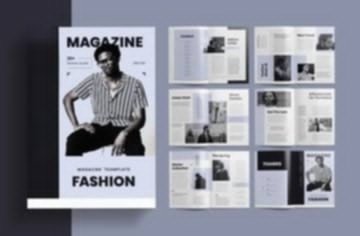
1. The Cultural Pulse: Why Magazines Still Matter
Magazines—whether highbrow like The New Yorker or glossy imagery like Vogue—continue to shape public discourse, reflect societal trends, and influence consumer tastes. In an era dominated by short‑form digital content, the enduring allure of long‑form storytelling, beautifully curated visuals, and thematic editions remains unparalleled. From investigative reporting to visual fashion editorials, magazines foster deeper connections than fleeting tweets or clips.
2. The New Yorker: Crafting the Intellectual Conversation
A benchmark for literary journalism and thoughtful critique, The New Yorker serves as a barometer of intellectual and cultural life. Its blend of essays, reporting, fiction, cartoons, and in‑depth profiles bridges the gap between scholarly reflection and mainstream readability. Whether tackling political upheavals, climate change, or major cultural shifts, The New Yorker shapes conversations that resonate globally.
3. Vogue: Fashion, Identity, and Visual Storytelling
Few magazines have the aesthetic power of Vogue. As the premier fashion authority, it crafts narratives through stunning editorials that elevate fashion to art. But Vogue is more than just runway reports—it’s a chronicler of cultural movements, featuring stories about diversity, sustainability, and the blurred lines between fashion, politics, and celebrity. Its iconic covers often reflect evolving standards of beauty and identity.
4. Hello!: Celebrity, Positivity, and Human Connection
With its upbeat tone and glossy international style, Hello! magazine gives readers an intimate look into the lives of celebrities and royals. The magazine thrives on warmth and emotion — highlighting milestones, engagements, birthdays, and philanthropic efforts. Its visual-centered storytelling makes it feel personal, allowing readers to feel connected to public personalities.
5. EatingWell: Wellness, Sustainability, and Flavor
EatingWell occupies the vital intersection of health, sustainability, and delicious food. At a time when diet culture and wellness trends shift rapidly, this magazine grounds readers with evidence-based nutrition, seasonal recipes, and eco-conscious advice. Whether tackling plant-based diets, food sourcing, or mindful eating, EatingWell empowers readers to make impactful lifestyle choices—one nutritious recipe at a time.
6. Mad Magazine: Satire in Ink
Mad Magazine, with its mischievous grin and irreverent humor, revolutionized satire in mid-20th century America. Its parodies of pop culture, uncanny caricatures, and biting social commentary made it a staple for adolescent rebellion and counterculture. Though its influence has waned since its peak, the spirit of Mad lives on in today’s memes, satirical websites, and comic strips.
7. New York Magazine: Urban Life Under the Microscope
New York magazine captures the heartbeat of the city that never sleeps through sharp features, restaurant reviews, and political reporting. From in-depth profiles of emerging entrepreneurs to investigations into urban planning and gentrification, it reflects the many voices that shape modern urban life. It excels at chronicling the intersection between the personal and the structural in a bustling metropolis.
8. Highlights Magazine: Growing Readers from Childhood
Highlights magazine stands apart as the beacon of wholesome childhood entertainment. With puzzles, stories, science corner, and moral tales, it champions curiosity and critical thinking in children. The famous “Goofus & Gallant” cartoons teach ethical lessons in a gentle, engaging way. For generations, parents have trusted Highlights to blend learning with fun, offering screen-free enrichment.
9. Behind the Magic: The Power of Magazine Covers
A magazine cover is more than decorative—it’s a cultural artifact. The right photo, color palette, and headlines can define a moment. New Yorker covers spark conversations about art and memory; Vogue covers signal new beauty ideals; Hello! covers invite us into intimate world moments; Mad covers mock those conventions entirely. In that thumbnail-sized frame, entire trends are condensed—the power of narrative visual design in one glance.
10. Threads That Tie the Titles Together
While each magazine plays to different audiences and formats, they share core strengths:
- Storytelling craft: Whether through essays, features, poetry, or humor, each title honors storytelling in a distinct way.
- Curation: Editors select what matters—an investigative profile, a powerful image, a healthy recipe, or a comedic spoof.
- Identity & aspiration: Vogue and Hello! reflect who we want to be; Highlights shapes who we’re growing to be; Mad offers the release of satire.
- Visual influence: Striking layouts and covers trigger both emotion and cultural memory.
11. Navigating Modern Challenges
The digital age poses challenges—declining print subscriptions, the need for social media reach, and competition with on‑demand video. But it also brings opportunities:
- Digital tie‑ins: Many magazines (like Vogue and New Yorker) extend their presence online through podcasts, subscription apps, and premium web content.
- Community building: Reader forums, live events, and paid newsletters foster a sense of belonging.
- Hybrid models: Premium print for collectors and digital for instant access is becoming the norm.
12. What’s Ahead: Trends and Innovations
- Purpose-driven content: Readers increasingly want magazines that align with values—diversity, sustainability, mental health, empowerment.
- Personalization: AI-driven content suggestions or subscriber-specific editions are on the rise.
- Independent voices: The magazine landscape is diversifying, with niche publications emerging in art, tech, subcultures, wellness, and beyond.
- Sustainability: Eco-friendly print processes, recycled paper, and carbon-neutral distribution reflect larger environmental concerns.
13. Impact on Culture, Identity, and You
Now more than ever, magazines influence how we see ourselves and the world. EatingWell can nudge us toward healthier habits. Vogue challenges beauty norms. New Yorker shapes political discourse. Mad tweaks our skepticism. Highlights ignites childhood imagination. In each case, the magazine offers both content and community—and those continue to matter in an age of fast scrolling.
14. Final Reflections: Why We Still Flip Pages
- Tangibility & trust: A printed magazine carries a sense of permanence and reliability.
- Editorial vision: Unlike algorithmic feeds, magazines offer a human–curated window into culture.
- Shared cultural touchstones: Iconic covers and issues become part of collective memory (Vogue’s first cover featuring a woman of color, The New Yorker’s depiction of global events, a beloved Mad parody).
- Rhythmic ritual: Subscribing, receiving, and savoring an issue marks time meaningfully.
Honoring the Spectrum
From the introspective essays of The New Yorker, to haute couture of Vogue, the celebrity warmth of Hello!, the healthy dishes of EatingWell, the satirical punch of Mad, the urban depth of New York, and the childlike wonder of Highlights, magazines are not relics—they’re living snapshots of culture. Each cover and each issue offers value: knowledge, escape, laughter, reflection, or connection.
Conclusion
Magazines remain vital. Whether we’re chasing trends, seeking inspiration, nurturing young minds, fueling our health journeys, yearning for laughter, or chasing intellectual engagement, these titles serve as companions and anchors. As long as humans crave thoughtfully curated voices, beautiful storytelling, and moments of pause, magazines—on paper or pixel—will endure.
Let me know if you’d like a shorter version, an infographic, or to shift focus toward any one publication or theme!





